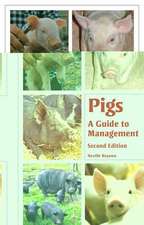Principles of Agronomy for Sustainable Agriculture
Editat de Francisco J. Villalobos, Elias Fereresen Limba Engleză Hardback – 5 noi 2024
The first section gives an overview of the crop energy balance, which covers partitioning of net radiation, and their effect on the thermal environment of the canopy. Water balance, as one of the biggest concerns under a changing climate, will also be thoroughly discussed. For the second section, the authors prepare all relevant information on crop production in relation to crop phenology, radiation interception and resource availability. With that in mind, the different agricultural techniques are analyzed in the third section, with special emphasis on quantifying the inputs required for a given target yield under specific environmental conditions. For each technique, the chapters provide guidance on improving the ratio between productivity and resource use, while ensuring sustainability.
| Toate formatele și edițiile | Preț | Express |
|---|---|---|
| Paperback (1) | 1045.10 lei 38-45 zile | |
| Springer International Publishing – 13 iul 2018 | 1045.10 lei 38-45 zile | |
| Hardback (2) | 1468.44 lei 38-45 zile | |
| Springer International Publishing – 9 feb 2017 | 1468.44 lei 38-45 zile | |
| Springer International Publishing – 5 noi 2024 | 1569.09 lei 6-8 săpt. |
Preț: 1569.09 lei
Preț vechi: 1913.52 lei
-18% Nou
Puncte Express: 2354
Preț estimativ în valută:
300.26€ • 321.07$ • 250.34£
300.26€ • 321.07$ • 250.34£
Carte tipărită la comandă
Livrare economică 18 aprilie-02 mai
Preluare comenzi: 021 569.72.76
Specificații
ISBN-13: 9783031691492
ISBN-10: 3031691490
Pagini: 700
Ilustrații: Approx. 700 p. 350 illus., 200 illus. in color.
Dimensiuni: 155 x 235 mm
Greutate: 1.15 kg
Ediția:Second Edition 2024
Editura: Springer International Publishing
Colecția Springer
Locul publicării:Cham, Switzerland
ISBN-10: 3031691490
Pagini: 700
Ilustrații: Approx. 700 p. 350 illus., 200 illus. in color.
Dimensiuni: 155 x 235 mm
Greutate: 1.15 kg
Ediția:Second Edition 2024
Editura: Springer International Publishing
Colecția Springer
Locul publicării:Cham, Switzerland
Cuprins
Chapter 1: Agriculture and agricultural systems.- Part I: The crop environment.- Chapter 2: The soil Physical, chemical and biological properties.- Chapter 3: The radiation balance.- Chapter 4: Wind and turbulent transport.- Chapter 5: Air temperature and humidity.- Chapter 6: Soil temperature and soil heat flux.- Chapter 7: The energy balance.- Chapter 8: The water budget.- Chapter 9: The components of evapotranspiration.- Chapter 10: Calculation of evapotranspiration and crop water requirements.- Part II: Crop productivity.- Chapter 11: Crop development and growth.- Chapter 12: Plant density and competition.- Chapter 13: Radiation interception, radiation use efficiency and crop productivity.- Chapter 14: Effects of water stress on crop production.- Chapter 15: Limitations to crop productivity.- Part III: Crop management.- Chapter 16: Sowing and planting.- Chapter 17: Tillage.- Chapter 18: Soil conservation.- Chapter 19: Irrigation systems.- Chapter 20: Irrigation scheduling using the water balance.- Chapter 21: Irrigation scheduling using plant- and soil-based methods.- Chapter 22: Deficit irrigation.- Chapter 23: Optimizing irrigation.- Chapter 24: Control of salinity.- Chapter 25: Fertilizers.- Chapter 26: Nitrogen fertilization I: The nitrogen balance.- Chapter 27: Nitrogen fertilization II: Fertilizer requirements.- Chapter 28: Fertilization with phosphorus, potassium and other nutrients.- Chapter 29: Fertigation.- Chapter 30: Soil improvement and reclamation.- Chapter 31: Manipulating the crop environment.- Chapter 32: Frost protection.- Chapter 33: Control of weeds and other biotic factors.- Chapter 34: Application of herbicides and other biotic control agents.- Chapter 35: Harvest and conservation.- Chapter 36: Cropping and farming systems.- Chapter 37: Energy consumption in agriculture.- Chapter 38: Remote sensing.- Chapter 39: Site-Specific Agriculture.- Chapter 40: Crop models.- Chapter 41: Climate change adaptation and mitigation.- Chapter 42: Agronomy and the sustainability of crop production.- Chapter 43: Quantitative analysis of crop production in an irrigated farm (Part I).- Chapter 44: Quantitative analysis of crop production in an irrigated farm (Part II).
Notă biografică
Francisco J. Villalobos is Professor of Agronomy at the University of Cordoba, Spain. He obtained his PhD at the University of Cordoba and then worked as a postdoc in the group of Joe T. Ritchie at Michigan State University. His teaching has been primarily on agronomy and on crop modelling. His research at the Institute for Sustainable Agriculture (IAS-CSIC) has focused on crop simulation models (sunflower, olive) and agrometeorology (evapotranspiration, water balance). He has been the Editor in Chief of the European Journal of Agronomy for ten years.
Elías Fereres is Emeritus Professor of Agronomy at the University of Cordoba, Spain. He studied agronomy engineering at the Polytechnic University of Madrid and got his PhD at the University of California, Davis, where he worked afterwards for six years. His teaching has been on agronomy, water relations and irrigation. His research at IAS-CSIC has covered various aspects of water-limited agriculture and irrigation management. He has been Chief Editor of the journal Irrigation Science, and President of the Royal Academy of Engineering of Spain.
Elías Fereres is Emeritus Professor of Agronomy at the University of Cordoba, Spain. He studied agronomy engineering at the Polytechnic University of Madrid and got his PhD at the University of California, Davis, where he worked afterwards for six years. His teaching has been on agronomy, water relations and irrigation. His research at IAS-CSIC has covered various aspects of water-limited agriculture and irrigation management. He has been Chief Editor of the journal Irrigation Science, and President of the Royal Academy of Engineering of Spain.
Textul de pe ultima copertă
This updated second edition textbook explains the different technologies of agronomy to achieve a more sustainable agriculture, for undergraduate and graduate students of agronomy.
The first section gives an overview of the crop energy balance, which covers partitioning of net radiation, and their effect on the thermal environment of the canopy. Water balance, as one of the biggest concerns under a changing climate, will also be thoroughly discussed. For the second section, the authors prepare all relevant information on crop production in relation to crop phenology, radiation interception and resource availability. With that in mind, the different agricultural techniques are analyzed in the third section, with special emphasis on quantifying the inputs required for a given target yield under specific environmental conditions. For each technique, the chapters provide guidance on improving the ratio between productivity and resource use, while ensuring sustainability.
The first section gives an overview of the crop energy balance, which covers partitioning of net radiation, and their effect on the thermal environment of the canopy. Water balance, as one of the biggest concerns under a changing climate, will also be thoroughly discussed. For the second section, the authors prepare all relevant information on crop production in relation to crop phenology, radiation interception and resource availability. With that in mind, the different agricultural techniques are analyzed in the third section, with special emphasis on quantifying the inputs required for a given target yield under specific environmental conditions. For each technique, the chapters provide guidance on improving the ratio between productivity and resource use, while ensuring sustainability.
Caracteristici
Includes the fundamentals of field, horticultural and tree crop production combined in a single textbook Combines the emphasis on crop productivity with the need for sustainability in agriculture Fully revised 2nd edition for students in agricultural sciences









